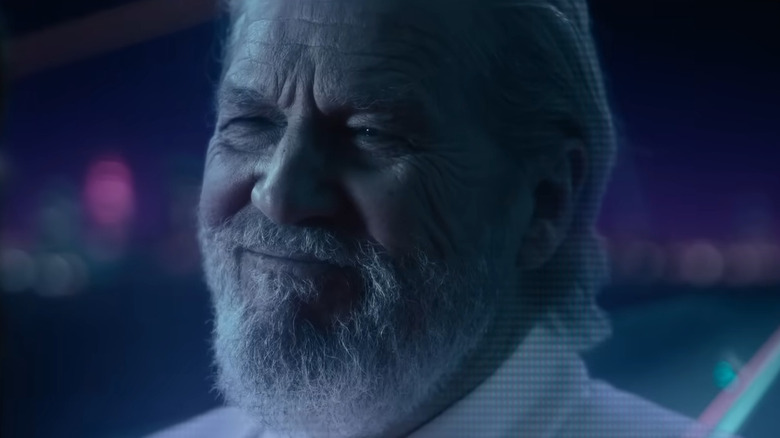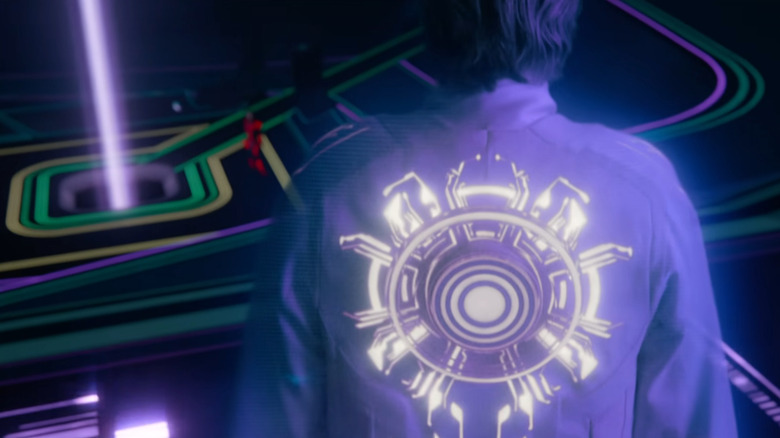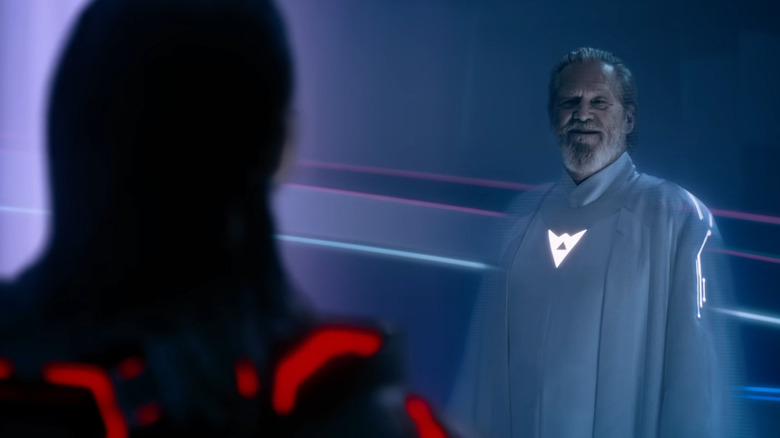Jeff Bridges' Tron: Ares Return Explained (To The Best Of Our Abilities)
This article contains spoilers for "Tron: Ares."
"Tron" has always been one of Disney's strangest, yet visually striking franchises. The 1982 cult classic and its 2010 legacy sequel were largely experimental "what ifs" about a digital dimension beyond ours that could produce societies, religion and the concept of free will. We could only dream of the technological possibilities looming on the horizon, and with the troubling rise of AI breakthroughs, "Tron: Ares" seemed like an ample opportunity to really expand upon its concepts of the two worlds converging. Sadly, the Joachim Rønning-directed entry is a thoughtless sequel that's more interested in moving thinly-written characters from point A to point B without much introspection towards the implications of such a merger.
Taking place 15 years after "Tron: Legacy," "Ares" sees tech companies ENCOM and Dillinger Systems in a race to perfect a 3D printing machine that can successfully pull digital constructs from their servers. At the center of this conflict is Ares (Jared Leto), a Master Control program who grows weary of being one of Julian Dillinger's (Evan Peters) expendable soldiers. Anything transferred from the Grid can only last up to 29 minutes before deresolution, which leads to an escalation in company warfare to retrieve the Permanence Code. ENCOM CEO Eve Kim (Greta Lee) discovers it in one of the files of the company's former founder Kevin Flynn (Jeff Bridges), but breaks it when first confronted by Ares. In refusing orders to retrieve Eve's internal Permanence Code, Ares helps Eve escape Dillinger's Grid back to the real world where they seek to upload Ares into Flynn's original Game Grid to obtain a backup.
Upon being digitized, Ares comes face to face with none other than Flynn himself. "Ares" doesn't give easy answers as to how he's still alive after "Legacy," but we can make some assumptions.
Ares' Kevin Flynn is pretty much a digital ghost on the original Grid
At the end of "Legacy," Flynn saves his son Sam (Garrett Hedlund) by reintegrating with Clu (a de-aged Bridges), therefore eliminating himself, the rogue AI program and all of his army. It creates a partial clean slate for the Grid. So if Flynn's definitively dead, then how is he in "Ares?" For starters, the Grid we see in "Legacy" was a separate experimental hub on a private server in the computer genius' arcade basement. ENCOM and Dillinger Systems each have their own Grid mainframes, but the one Bridges appears in here should come as no surprise to those who have seen the original "Tron." With Flynn's office being preserved near the top of ENCOM headquarters, so is the original Game Grid that he became trapped in. It's an entirely different space.
"Ares" seeks to interpret Flynn as more of a digital spirit than anything else. I suppose this would make partial sense considering he was the one who initially built it back in the '80s. It's easy to imagine Flynn uploading a program with his likeness. What makes it really strange though is that he's represented as present day Bridges, one who looks and sounds even older than he did in "Legacy." The most plausible explanation for this probably lies in Rønning not wanting to touch the de-aging dilemma with a ten foot pole. Hence, this Flynn is a holographic spirit who gives Ares the Permanence Code he desires. In this way, Bridges is not really a character so much as a plot device.
Flynn is more of a nostalgic plot device than an actual character
Disney was initially set to obscure Bridges in the marketing for "Ares," but the OG "Tron" star forced their hand and revealed his inclusion in the new film anyways. What followed was a featurette entitled "Flynn Lives," which teased the character's big return. In the film, however, Flynn is not really much of a character. There's a moment when Ares asks how he's even alive, to which the digital ghost responds with "I exist in this moment because you do." The Grid's Flynn is merely a reflection of the subtitular program's presence. It's the "Tron" equivalent of "ah, don't worry about it." Through a more cynical lens, it has to do with being one of many easy distracting nostalgia grabs that stops the film dead in its tracks to address.
"Ares" is eager to point out all of the iconographies of the original "Tron" including the primitive Grid layout, the light cycles, Wendy Carlos' score, and, of course, Bit. You know you're in the OG Game Grid because the crack in the light cycle arena is still there. Flynn is essentially manifested to pass the baton onto Ares to carry on the "Tron" legacy. It's a shame that Leto is the new face of this franchise considering he's stiff as a board here, and not even in a way that informs his character. The most striking parallels of Flynn return can be made in comparison to Luke Skywalker (Mark Hamill) in the "Star Wars" sequel trilogy. The exiled master of their craft sacrifices themselves to let the new generation build a new future, only to show up in the next film as a white-robed apparition trapped in a singular scene born out of nostalgic reverence.
"Tron: Ares" is now playing in theaters nationwide.


